sl Collective is a Los Angeles-based architecture and design firm that translates identities and concepts into built environments. Established in 2020, sl Collective is a new model for expanded and scalable practice, formed by a group of individuals who work globally with forward-thinking clients on a wide range of projects, including buildings, interiors, industrial design, design-research consulting and ideation.
Year: Ongoing (2020)
Location: Brussels, Belgium
Commissioned by: Private Client, LLC
Project Team: Gillian Shaffer
Description: Addition, Spa, +45 sq m
Porte de Namur is a new-build addition, stacked on top of a structure within a residential courtyard located in the center of Brussels. Offset from the main rue, the courtyard is defined by a cluster of multi-family housing buildings and the facade of a historic chocolate factory that is the backdrop to the site. The design of an upstanding modulated volume with a deep roof of skylights and pitched gables maintains a maximum footprint for a +45 sq m second floor extension of a wellness spa. The use of a translucent ribbed-glass cladding material creates a bright interior ambience within the added feature space, to be used for restorative treatments, somatic bodywork and yoga classes. At night the new volume lights and glows from within, softly illuminating the courtyard. The capped addition subtly reinterprets traditional Belgian rooflines and their formal autonomy, dialoguing between historic and contemporary contexts.
Year: Ongoing (2020)
Location: Los Angeles, CA
Commissioned by: Private Client
Project Team: Gillian Shaffer
Program: Single Family, Residence, approx. 1060 sq ft
Located in east Los Angeles, the House Before a House has a lush and living presence, with central outdoor courtyards and skylights punctuating the plan. Together, the outfitted rooms form a set of interlocking environments with plants and landscaping layering and flattening across views through the house. Composed of a single family home with a detached artist’s studio, the House brings into question how a family unit might grow and scale over time, while also providing a backdrop to inspire creativity and disseminate work. The House is responsive to the idea that the forces of technology and globalization will redefine domesticity yet again, blurring further the lines between work and home, urban life and retreat to nature, between leisure time with loved ones and physical travel, private life and public interior. In tension with the conceptualization of design, the limitations of site and cost, the House reconciles a couple’s need to be together while living highly dynamic and mobile lives.
Year: Projected 2022
Location: Devon, U.K.
Commissioned by: Private Client
Project Team: Gillian Shaffer
Program: Single Family Residence & Follies, 215 sq m
River Woods is a house with two folleys sited on a 10-acre plot of land deep within Dartmoor National Park, near Exeter. The new house frames the top of a plateau, overlooking the surrounding woods, rivers and ever-changing English landscape. The owner wanted a house that would bring the majestic scenery into the interior of the building, while also speaking to the vernacular, formal and environmental qualities that surround the site. Divided into an elevated ground floor with an entrance area, single bedroom, washroom, kitchen and dining, and living space, the floor plan openly flows from one room to the next. Full-height glazing gives unobstructed views and access to the expansive outdoors. Heavy, stacked planar volumes are the structural design elements, containing the language of ancient dolmens strewn across the landscape miles from the site. A central sculptural stair connects the elevated ground floor to a private roof garden, overlooking the property and valley beyond.
Year: 2019–2020
Institution: UCLA Architecture & Urban Design
Studio: IDEAS Urban Strategy Graduate Studio led by Jeffrey Inaba, Gillian Shaffer and David Iniesta Jimenez
Topic: The Future of LAND in Los Angeles, Urban Design
From its settlement to its series of expansions and finally its densification, reimagining land has been the vehicle for the city of Los Angeles to grow. One of the most remarkable attempts is Olmsted and Bartholomew’s 1930 plan to create an emerald necklace of parks from the Pacific Ocean through Downtown LA to the San Gabriel Mountains along the path of the LA River, transforming the land from a handful of disparate municipalities into a new regional geography of open spaces connected by transportation corridors. The ambitious proposal to give LA’s land an urban culture before it had one resonates today as plans for the LA River have prompted discussions about knitting the region together through a series of linked landscapes and urban attractors. Taking the Olmsted and Bartholomew plan as a source of inspiration to imagine the future of Los Angeles at a broad and visionary scale, final design proposals considered three key aspects of future LAND: (1) Nature—rather than battle nature to build, the students used it as a medium to grow the city using geography, landscape, and inclusive habitats, (2) Climate—because the land is changing students designed infrastructure and urban areas that improved the quality of life in a world of climate risk, and (3) New building types - the rising value of land means architects will need to create new types of buildings whose urban spaces make the best use of limited area in a city reluctant to densify.
Year: March 2020
Publication: Art in America
Title:Modeling Climate: A conversation on the role of visualization in both understanding and explaining climate change
Exchange with: Nick Lutsko and Michael Wang
Description: Interview
A conversation on the role of visualization in both understanding and explaining climate change. (Fig. 1)
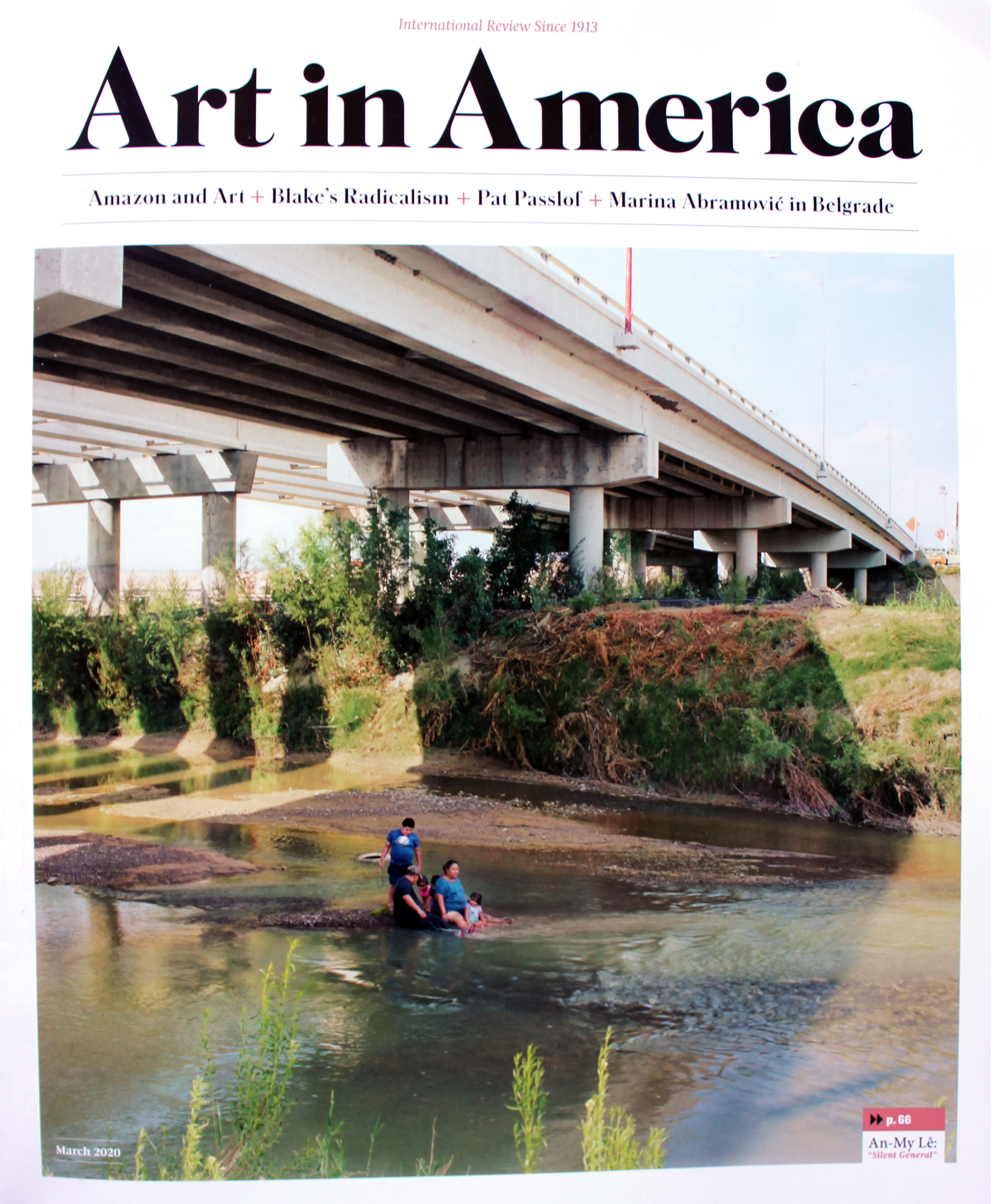
Nicholas Lutsko with Michael Wang (Fig. 2)
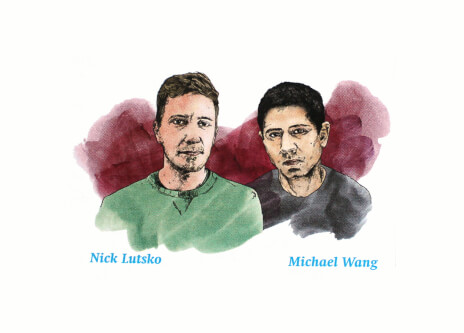
Climate scientist Nick Lutsko (NL) and artist Michael Wang (MW) met at Lutsko’s Los Angeles apartment last November, where the two compared their efforts to understand, model, and explain the complexities of climate change. Lutsko researches climate systems on a global scale—specifically, cloud processes and interactions between atmospheric and oceanic circulation patterns. Wang’s climate change art includes his series “Carbon Copies” (2012–), for which he offsets the carbon footprint of various highly visible contemporary artworks and modeled forms that illustrated their carbon impact. Below, the two discuss tropes of climate change art and the recent evolution in popular understanding of their areas of research.
NL: I think “Carbon Copies” is super cool. A lot of climate change art simply says “climate change is happening, this is bad.” Your work is more hopeful—you’re not shaming people for the environmental impact of their art, but showing that we can have nice things if we, for example, buy a carbon Offset.
MW: When I started this project in 2012, the idea of carbon offset was not as widely understood as it is now. I want “Carbon Copies” to show that highly visible artworks have shadows: their carbon footprints. My approach is to point away from the works—Marina Abramović’s The Artist Is Present (2010), Olafur Eliasson’s The Weather Project (2003)—and toward their environmental effects. By offsetting the works, I’m not only visualizing their usually invisible effects but also trying to work with the atmosphere itself as a medium.
Two sculptures from Michael Wang’s series “Carbon Copy.” (Fig. 3)
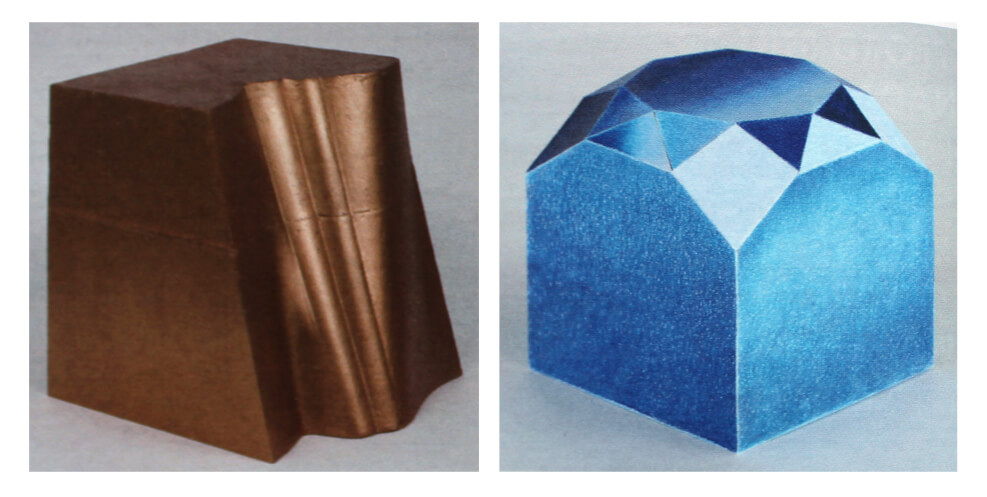 Left, We The People, 2010–13, 2016, plaster and metallic pigment, 8 by 8 inches; 84.01 tons CO2 removed from the atmosphere. Right, Jeff Koons, Diamond (Blue), 2005–06, 2012, colored pencil on paper, 3.5 by 3.5 by 3.5 inches; 84.01 tons CO2 removed from the atmosphere.
Left, We The People, 2010–13, 2016, plaster and metallic pigment, 8 by 8 inches; 84.01 tons CO2 removed from the atmosphere. Right, Jeff Koons, Diamond (Blue), 2005–06, 2012, colored pencil on paper, 3.5 by 3.5 by 3.5 inches; 84.01 tons CO2 removed from the atmosphere.NL: I’ve also noticed an increase in the general public’s understanding, especially in the past year, thanks to people like (activist) Greta Thunberg. Lately, it’s even gotten a little bit out of control: people are imagining major climate disasters. A colleague of mine recently did an informal study that asked people to rank, on a scale of one to nine, how bad they think the effects of climate change will be. Number one was the equivalent of the 2008 recession, two was the Great Depression… nine was total extinction of the human race. The average was around four or five. But the average among climate scientists was between one and two. I don’t think human society is in danger, but that’s the message that’s being broadcast right now. At first, no one cared about climate change; now everyone cares about it almost too much.
MW: In my work, I usually introduce people to a system they’re not familiar with, so there’s often a didactic element. I’m always trying to gauge what is widely understood and what is new information that needs to be introduced. Climate change has become a prevalent topic in mass media, but many people still don’t understand the basic processes that underlie it. I’ve done some mini-experiments among people I know. I’ve asked them: where does the mass of a tree come from? So far, no one has given me an adequate answer: that the carbon mass of a tree comes from the carbon dioxide in the atmosphere. Through the reactions of photosynthesis, air becomes solid. Basic relationships between plants and the atmosphere seem to remain obscure, even to highly educated people. For my project Cyan Sea (2018), I cultivated cyanobacteria in an ornamental pool, trying to showcase an early form of photosynthesis—the source of the first organic green. It’s very likely that the emergence of cyanobacteria was linked to one of the greatest mass extinctions on Earth. It probably created an oxygen catastrophe, since oxygen was poisonous to most microbial life at the time. The theory links a specific organism to an extinction event—which is pretty much the analogy today.
NL: People are saying that the emergence of conscious life, like the emergence of oxygen, leads to extinction.
MW: Though some ask: is it really the human species per se that’s causing all of this, or is it capitalism? I want to leave that question open. Your modeling work, I notice, is often on the scale of the planet.
NL: I work with currents and patterns that cover thousands of kilometers. That’s the scale that really matters in the atmosphere, where no horizontal boundaries exist. But, having said that, I do think that the cutting edge of this field is in regional climates. Most theoretical developments are highly abstract, but specialists are now adapting these concepts to more regional applications, since that’s the scale on which things actually affect us. MW: That opens up a lot of questions about resilience in the face of global change.
NL: Exactly. Scientists are in a tricky spot right now. For a long time, the emphasis was on understanding the climate system and showing that climate change is happening. But now that’s indisputable, so where do we go from here? For me, it’s really about zooming in and helping people adapt to climate change. I don’t think we’re going to stop it. At the moment, I’m really interested in temperature variability. It turns out that the most variable surface temperatures on Earth are in central North America—east of the Rockies, places like Nebraska or Kansas. Last year, there was a day when the temperature in this region went from below freezing to above eighty degrees. I want to understand how that works. People like to say that by 2100, everyone will have to move a hundred, or even several hundred kilometers north to experience the same climate. But my recent work emphasizes that, because of regional differences, average temperature isn’t the only factor: there’s also temperature variability. MW: That’s important to keep in mind as people are trying to find refugees from climate change. Climate systems are very complex. In the models we’re building, you can always add more variables and new data sets. The more you do, the more accurate— ideally—the models become. I’m working in the lineage of systems aesthetics and institutional critique: I want to make climate systems visible. And I find that there’s a limit to the amount of data one person can take in. So I find that I’m always using some process of reduction, or that I end up isolating one particular process to make the model more understandable. When the data gets too big, there’s a point where only a computer can really handle it.
NL: Scientists often critique these models as black boxes that people are basically fudging. On the one hand, yes, you want to make them as complex as you can. But if they’re too complex, then you can’t tell why they go wrong. There are always uncertainties, and the people who make the models are experienced with playing around to make what we would consider a “good model”: one that reproduces the observed climate. The process can feel very non-objective and unscientific. Some guy in a lab somewhere decides: I think I’m going to set this parameter to two, because that seems to work. But in terms of making projections, it’s the best we have… for now.
Lutsko, Lutsko, Total cloud cover (Fig. 4)
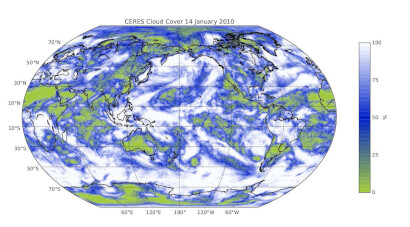 on January 14, 2010 as measured by NASA’s Clouds and the Earth’s Radiant Energy System (CERES) experiment. White colors indicate regions of 100% cloud cover.
on January 14, 2010 as measured by NASA’s Clouds and the Earth’s Radiant Energy System (CERES) experiment. White colors indicate regions of 100% cloud cover.Lutsko, average June-July-August downward energy flux (Fig. 5)
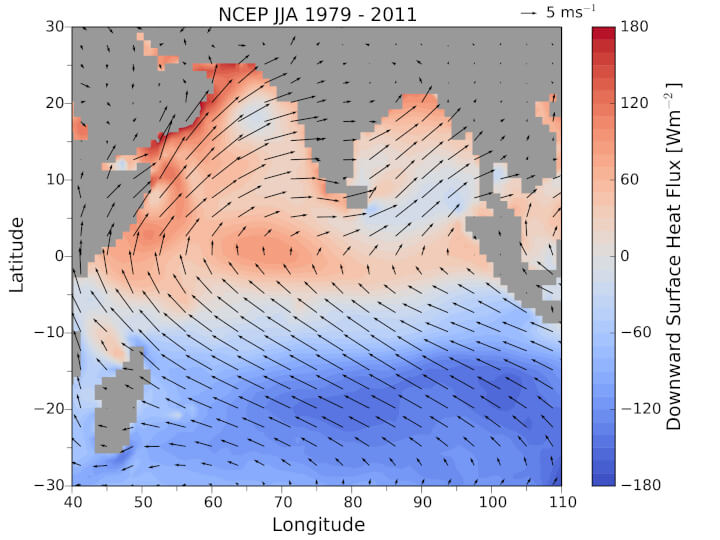 (colors) and surface winds (arrows), 1979–2011. Redder regions document where the ocean is taking up heat and bluer regions where the ocean is emitting heat to the atmosphere.
(colors) and surface winds (arrows), 1979–2011. Redder regions document where the ocean is taking up heat and bluer regions where the ocean is emitting heat to the atmosphere.MW: Researchers typically look at past climates to model current and future climates. I take a similar approach with my project Extinct in New York (2019–) (Fig. 6),
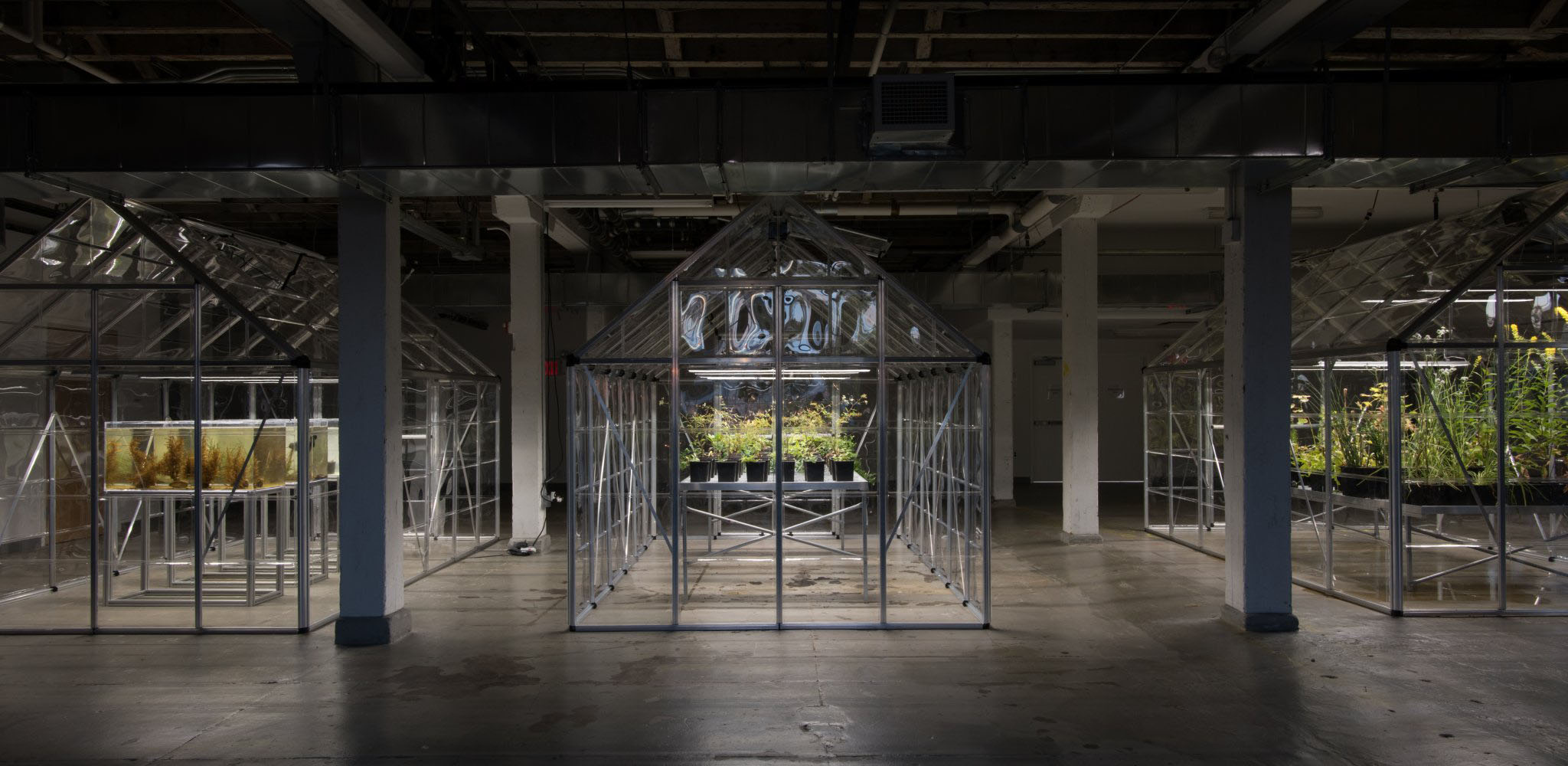 which I showed on Governor’s Island. I tried to look at the history of the New York City area, highlighting its many lost wetlands. I also catalogued all the plant, lichen, and algae species that were once found there but have vanished. I brought the species to New York and showed them in an installation of greenhouses. I saw this as a proposal for what the city could be: a place that welcomes back the organisms it displaced.
which I showed on Governor’s Island. I tried to look at the history of the New York City area, highlighting its many lost wetlands. I also catalogued all the plant, lichen, and algae species that were once found there but have vanished. I brought the species to New York and showed them in an installation of greenhouses. I saw this as a proposal for what the city could be: a place that welcomes back the organisms it displaced.NL: You have another extinction project.
MW: Yes, Extinct in the Wild (2017–). It looks at organisms that are normally found in nature but now exist only in captivity or in cultivation.
Two photos from Wang’s project Extinct in the Wild, 2017–. Barranco Tamadaya in Tenerife, Spain, a former habitat of Lotus berthelotii (Parrot’s Beak perennials).
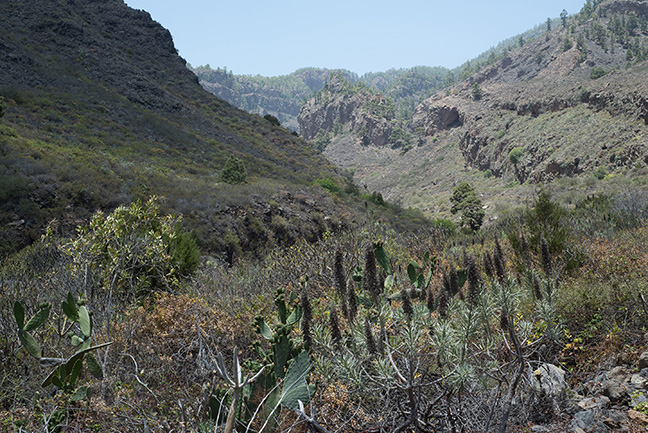 The plants being grown in captivity in Iglesia de San Pedro, Tenerife, Spain.
The plants being grown in captivity in Iglesia de San Pedro, Tenerife, Spain. NL: I really love this project, though I admit that when I first saw it, it felt a little eye-rolly. Like Olafur Eliasson’s ongoing “Glacier” series, where you’re forced to watch glaciers melt. But then I realized that you’re not showing all the extinct species, but rather the species that are extinct except in captivity. That’s a much more nuanced perspective: you’re calling attention to what’s been lost; but it’s not a total loss, and you’re highlighting the human hand.
NL: I really love this project, though I admit that when I first saw it, it felt a little eye-rolly. Like Olafur Eliasson’s ongoing “Glacier” series, where you’re forced to watch glaciers melt. But then I realized that you’re not showing all the extinct species, but rather the species that are extinct except in captivity. That’s a much more nuanced perspective: you’re calling attention to what’s been lost; but it’s not a total loss, and you’re highlighting the human hand.MW: With Extinct in the Wild, I wanted to show the double-edged effect of Homo sapiens on other species. On the one hand, nearly all of the species extinctions in this project are related in some way to human actions. But their survival is also contingent on human preservation.
NL: And we’re also curating what survives. Plenty of species go extinct that aren’t in captivity, like bugs. We chose to preserve certain species for a reason.
MW: Within the catalogue (query pending)—I imported various species and showed them inside life-support systems that I created—are many types of relationships between humans and other species. It can be complete exploitation, as with the aurochs, who were the victims of the first extinction to be historically recorded, which took place in Poland in the seventeenth century. Aurochs are the wild ancestor of domestic cattle. They were prized as game animals, but they went extinct partly from diseases introduced by domestic cattle. Ironically, this extinction is linked to us—probably the most populous large mammal on Earth—through human husbandry. For me, that story really highlights the strangeness of this category, and also suggests the many possible relationships that humans can have with other species.
I met with researchers in Hawaii who keep some of the last populations of terrestrial Hawaiian snails (Fig. 8),
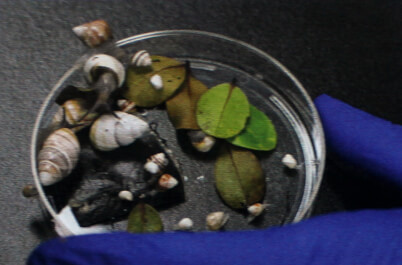 in captivity. These native snails were probably endangered by nonnative predatory snails. In this case, captivity is an act of preservation. WANG In your work on precipitation, you move between the micro and the macro in super complex ways.
in captivity. These native snails were probably endangered by nonnative predatory snails. In this case, captivity is an act of preservation. WANG In your work on precipitation, you move between the micro and the macro in super complex ways.NL: The subject forces you to be really creative in your approach. For instance, we have to try to find indirect ways of measuring clouds—which are the biggest area of uncertainty in climate change, especially their effect on surface temperature. We’re not sure if we should expect more clouds, which would help offset some of the effects of CO2, or fewer clouds. They’re hard to measure. How do you define a cloud? There’s satellite data, but how do you capture overlapping clouds?
MW: In my practice, I often think that I’m more interested in using synecdoche than metaphor as a strategy. For Extinct in New York, I brought in actual components of the system I wanted to address, not some sort of stand-in that represents the system. In your research, are you looking at a fragment of something larger? Or are the computational models you’re creating more of a metaphor?
NL: We work only in metaphors, essentially. Of course, people fly through clouds and make observations, which would be more of a metonym. And obviously we incorporate observations. For my work on temperature variability, I worked with a sphere that represented the earth and had one bump on it, kind of like the Himalayas. Then, I observed how that bump affects temperature variability on either side of it. I used those observations to develop a theory, which I used to develop more complex models.
MW: I want my audience to experience climate change on a oneto- one scale. I can only show fragments of these global systems.
NL: I think that’s an important strategy for making people care, since so much of this stuff is beyond our ability to Understand.
MW: People sometimes ask if my work is art or science, which I think is a stupid question. You are a scientist. You’re creating new knowledge. I’m drawing on scientific work, but it’s not building upon that research: my aim is to create spaces that allow people to understand the world in ways that are familiar to scientists but relevant to everyone and should be common knowledge.
NL: This might sound cheesy, but there are definitely a lot of aesthetic choices and intuition that go into making a model look elegant and understandable. That makes this question of art versus science kind of meaningless.
—Moderated by Emily Watlington
NICK LUTSKO is an assistant professor of climate science at the Scripps Institution of Oceanography at the University of California San Diego.
MICHAEL WANG is an artist whose new media projects often address ecological issues. He recently had solo exhibitions at LMCC's Arts Center at Governors Island, New York (2019), and the Fondazione Prada, Milan (2017).
Fig. 1: Art in America, March 2020. Modeling Climate A conversation on the role of visualization in both understanding and explaining climate change.
Fig. 2: Art in America, March 2020. Nick Lutsko with Michael Wang.
Fig. 3: Art in America, March 2020. Michael Wang’s series “Carbon Copy.”
Fig. 4: Art in America, March 2020. Nick Lutsko, Total Cloud Cover (2017).
Fig. 5: Art in America, March 2020. Nick Lutsko, Average June-July-August Downward Energy Flux (2018).
Fig. 6: Art in America, March 2020. Michael Wang, Extinct in New York (2019) at LMCC Arts Center at Governors Island, New York.
Fig. 7: Art in America, March 2020. Michael Wang, Barranco Tamadaya in Tenerife, Spain. A former habitat of Lotus berthelotii (Parrot’s Beak perennials).
Fig. 8: Art in America, March 2020. Michael Wang. The plants are being grown in captivity in Iglesia de San Pedro, Tenerife, Spain.
Fig. 9: Art in America, March 2020. Michael Wang. Achatinella fulgens (land snails) at the Snail Extinction Prevention Program in O’ahu, Hawaii.
Year: April 2018
Location: Van der Plas Gallery, New York City
Exhibition by: Princeton University
Including works by: Kate Bilyk, Samuel Clovis, Isidoro Michan Guindi, Leen Katrib, Yujun Mao, Juan Salazar, Kyle Schumann, Gillian Shaffer, Eda Yetim
Curators: Gillian Shaffer & Samuel Clovis
Graphic Design: Burrow, Berlin
Photography: Miguel de Guzman
Nine Constructionists represent a new wave that thinks about architecture in relation to its physicality, its materials and its construction. Derived from the latin word cōnstruō—con meaning “together” and struo meaning to “pile up, arrange; build, erect”— the term “construction” implies an act of drawing together, a process that occurs alongside the making of physical objects. For the architect, construction is as much about the theory behind the spatial relationships or material decisions as it is about the act of combining materials. In the same way, the Nine Constructionists are also concerned with the dynamic temporality of materials moving through the construction process, and not solely with the physical process of construction making. This emphasis on the construction of architecture produces an effect of transience, of things in the process of being built or dismantled. Like ruins, many of these architects rely upon a temporal physicality: things don’t seem to fit together perfectly; rather, they reveal their construction.
This exhibition foregrounds a shift in post-professional thesis at Princeton University School of Architecture from a model of individual projects to group ambitions that reflect common training, influences and life experiences, as a response to the contemporary moment. Both “projective” and “discursive,” the projects on exhibit critically engage with the multifaceted condition of contemporary architecture. The exhibition comprises the works of nine emerging architects, including architectural drawings, models, mock-ups, robotics, films and projections, photographs, and print media. The exhibition spans two segments, (Re)construction and Ruination and Constructing the Domestic, which investigate the temporal and material aspects of architecture through making use of the existing or else by making anew. Nine Constructionists seeks to spark critical inquiry and debate by inviting experts and general audiences alike to witness the new interpretations of an emerging generation of architectural thinking.
Year: 2018-2019
Site: Embassy District, Havana, Cuba
Project Team: Gillian Shaffer
Description: Extraterritorial Architecture
Vision has always been among the structuring topoi of architecture as a discipline; however, the relationship of vision to the built environment is being rapidly disrupted by digital technologies. In an era of smartphone cameras, satellites and Google Earth, image recognition algorithms, and new spectral ranges of vision, unfamiliar temporal and spatial relationships are being created that do not correspond to human cognition. Technology now mediates the visibility of buildings, and space has become reducible to data.
The Ambassador’s House is a kind of limit condition to test the architectural implications of new forms of vision, where architectural aesthetics themselves become a form of camouflage. The resulting redefinition of what it means for a building to “be seen,” and the implications for building typologies and spatial organizations more generally, have motivated an investigation of (1) the polemicization of roofs in response to satellite vision and the more general question of how a house could be constructed in order to keep its plan from being extrapolated from these images, (2) an invented toolkit of visuality to address questions of programmatic opacity and transparency, involving the ambiguity of screens for windows, the materiality of facades, and the pixelation of images to obscure their recognition by software, and (3) an argument that new technologies require the definition of “vision” has to be enlarged to encompass data that can be obtained from household appliances (ie. laundry loads, waste, and floor plans surveyed by Roomba vacuum cleaners), wearables (ie. heart rates and health monitors), and everyday technologies of all types/ scales. The influence of new technologies is characterized by its ubiquity: we all live digitallymediated lives, feeding data—visual and otherwise—to the machines around us.
Exhibited in Aesthetics of Prosthetics, Siegel Gallery, New York City and Nine Constructionists, Van der Plas Gallery, New York City.
→ Watch video
→ See full publication
Year: 2021–2024
Location: Salton Sea, California
Commissioned by: Grant Funding
Project Team: Gillian Shaffer, Chinmayi Suri, Florian Lepinard, and Ruchi Singhania in collaboration with UCSD climate scientist Amato Evan, Alden Studios
Program: Climate Research Facility & Community Center, 1400 sq ft
Dust is the medium by which the atmosphere gains materiality. Satellite images show dust from space as it is carried vast distances by weather patterns, illustrating the swirling eddies and jets which make up the atmosphere’s global circulation. The Salton Sea Facility for Climate Research is a combined research space and educational/community center near the Salton Sea, which supports dust research led by UCSD climate scientists and serves as a didactic tool for illustrating the rapidly changing climate of the Salton Sea region. A permeable membrane filters dust, isolating it from detritus (organic matter, trash, etc.), and forming a stratigraphy which acts as a physical embodiment of environmental change, rendering the invisible concept of climate change visible. In this way, the project is at the intersection of multiple time-scales: the time-scales of the humans who observe the dust, the time-scale of the building which transitions from inhabitation to a data record, and the time-scale of environmental change, which will continue even after rising dust levels render the Salton Sea unlivable.
Year: 2020
Publication: POOL Magazine, No. 5 Simulation
Titel: The Synthetic View: When Simulation Doubles Reality Written by: Gillian Shaffer
Description: Essay
Gillian Shaffer
Vision has always been among the structuring topoi of architecture as a discipline. However, the relationship of vision to the built environment is being rapidly disrupted by digital technologies. In an era of smartphone cameras, satellites, image recognition software, and new spectral ranges of vision, unfamiliar temporal and spatial relationships are being created that do not correspond to human cognition. Technology now mediates the visibility of objects, and space has become reducible to data. Buildings can be viewed and rendered through an interface, recreated with point clouds or reconstructed through the lens of algorithms. Moreover, the definition of “vision” has to be enlarged to encompass data that can be obtained from household appliances (laundry loads, waste, floor plans surveyed by Roomba vacuum cleaners), wearables (heart rates and health monitors), and everyday technologies of all types and scales. The influence of new technologies is characterized by their ubiquity: we all live digitally-mediated lives, feeding data—visual and otherwise—to the machines around us.
This new Synthetic View defines a space of simulation, in which multiple digital spaces are inscribed on top of physical environments, converging and intersecting across time-scales into a dynamic field of simultaneous temporalities. Recognizing this, architects and designers must now respond to the Synthetic View, which takes into account many possible technological perspectives, all of which operate apart from traditional relationships to human figure. In this essay, I place the Synthetic View in the larger framework of the history of vision in architecture, then investigate how windows and screens can be used as a casement towards a theory of the Synthetic View. I then discuss several spatial manifestations of new technologies, some current and some ongoing. Ultimately, my goal is to start a discussion around how architects can reckon with the Synthetic View—in theory and in design.
I. Tools of Perception, From One to Many
In his Ten Books on Architecture01 Vitruvius positions and classifies the subject-object viewer as instantiating spatial organizations through a variety of sightline constructions, perspectival relationships, and bodily measurements (Fig. 1)
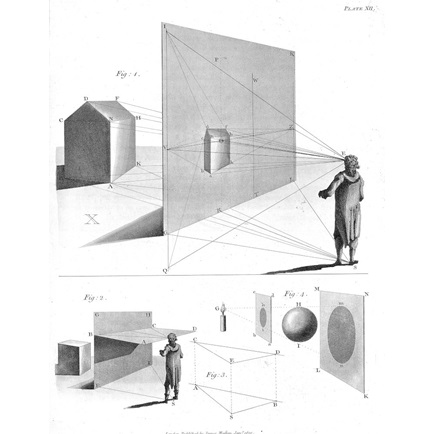 in order to get closer to, and more truthfully represent, an absolute architecture. Aimed at either satisfying the desires of noblemen and aristocrats, or overawing a visiting worshiper, this architecture was intensely concerned with the viewer: where they stood, what they saw, and what they experienced of space as a “total view”.
in order to get closer to, and more truthfully represent, an absolute architecture. Aimed at either satisfying the desires of noblemen and aristocrats, or overawing a visiting worshiper, this architecture was intensely concerned with the viewer: where they stood, what they saw, and what they experienced of space as a “total view”.The solitary subject-object relationship persisted throughout much of architectural history until, inspired by the writings of Foucault in the 1960s, the singular humanist subject was split into multiple subjects. Brought to be more polemic, this philosophical shift demonstrated power’s innate attachment to knowledge as a form of Truth through social and epistemic relations.02 Foucault revealed that, “power relations are rooted deep in the social nexus… Power is not something that is acquired, seized, or shared; power is exercised from innumerable points, in the interplay of non-egalitarian and mobile relations.” Individual practices and subjectivity were shown to be embedded into overarching structures and control systems. “Vision” and “sight” now referred to organizations and hierarchies: of a corporation, a government or a knowledge institution. Architecture was no longer about providing an experience to a single (typically highly privileged) viewer, but about analyzing and deconstructing the relationships between subjects and spaces, within the context of larger power hierarchies.
In just a few decades, the totalizing, data-rich view of technology has further fragmented the relationship between object and viewer. The resulting redefinition of what it means for a building to “be seen,” and the implications for building typologies and spatial organizations more generally, have interested a wide range of contemporary thinkers, including artist Hito Steyerl, geographer Trevor Paglen (Fig. 2),
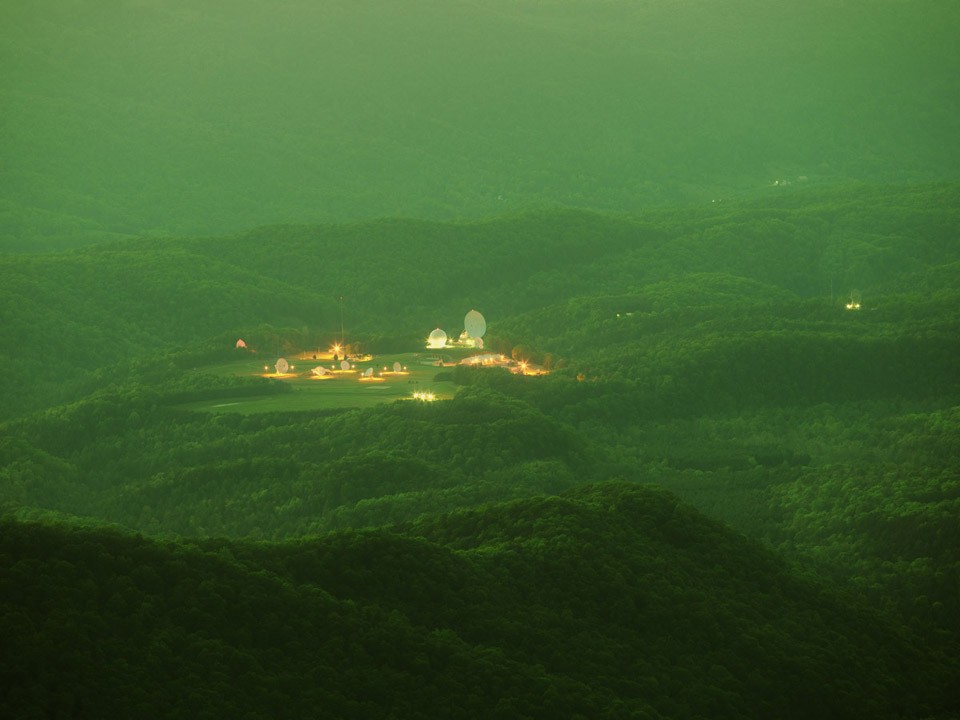 and architect Liam Young. Much earlier, an important antecedent to the contemporary situation is the “measured view” which emerged in the 17th century as part of the colonialist projects in pre-revolutionary France and Great Britain. Architects, archaeologists and cartographers, on their Grand Tour of the Europe of Antiquity, painstakingly measured and drew the monuments that they encountered, seeking to create objective re-creations of what they went to see. One can imagine Julien-David Le Roy’s (Fig. 3)
and architect Liam Young. Much earlier, an important antecedent to the contemporary situation is the “measured view” which emerged in the 17th century as part of the colonialist projects in pre-revolutionary France and Great Britain. Architects, archaeologists and cartographers, on their Grand Tour of the Europe of Antiquity, painstakingly measured and drew the monuments that they encountered, seeking to create objective re-creations of what they went to see. One can imagine Julien-David Le Roy’s (Fig. 3)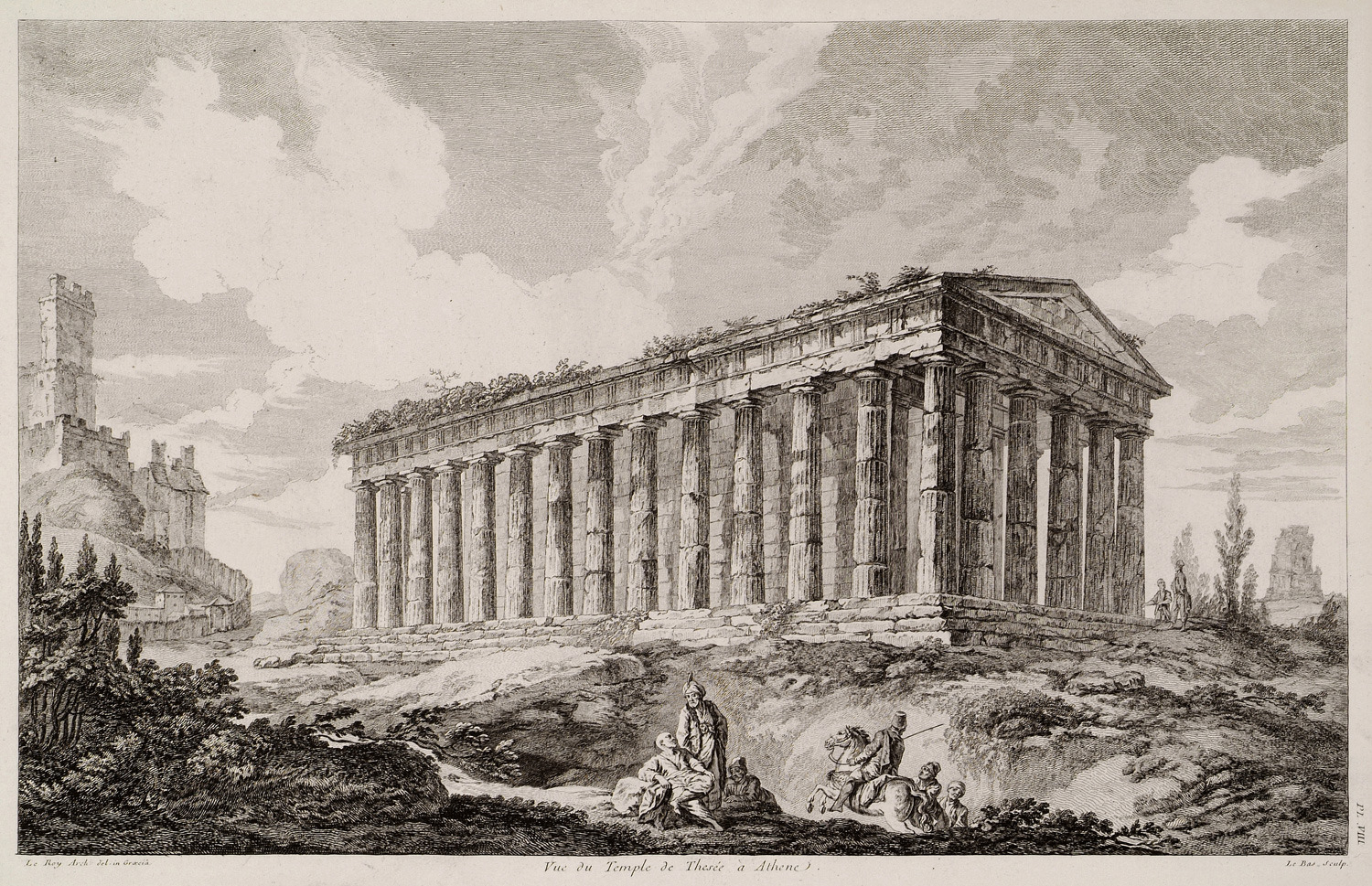 disappointment when he concluded that the Romans had often ignored Vitruvius’ plans in their buildings.03
disappointment when he concluded that the Romans had often ignored Vitruvius’ plans in their buildings.03The difference today is not just in the making of an analog versus digital map, the nature of the territory of information, or in the map itself, but that now we too are mapped. This was illustrated in Dan Graham’s prescient installation “Two Viewing Rooms” (1980) (Fig. 4),
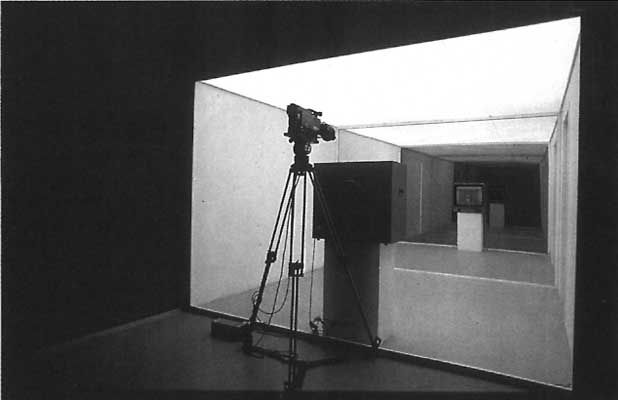 in which two adjacent gallery rooms were connected through a closed-circuit video. Visitors in Room A observed the behavior of visitors in Room B, who were confronted by their own images, as represented on a video monitor and reflected in two opposing mirrored walls. Through this installation, visitors had the subjective experience of being in a room, while simultaneously viewing themselves objectively standing within the scene of the room. This split vision of both objective and subjective realities places the visitors in Room B on either side of the “fourth wall”, and blurs the space of simulation which separates subject from object. If architecture mediates how a viewer observes a subject, Graham’s installation shows us that technology can be used to expand and re-imagine the filtering role of architectural interventions.
in which two adjacent gallery rooms were connected through a closed-circuit video. Visitors in Room A observed the behavior of visitors in Room B, who were confronted by their own images, as represented on a video monitor and reflected in two opposing mirrored walls. Through this installation, visitors had the subjective experience of being in a room, while simultaneously viewing themselves objectively standing within the scene of the room. This split vision of both objective and subjective realities places the visitors in Room B on either side of the “fourth wall”, and blurs the space of simulation which separates subject from object. If architecture mediates how a viewer observes a subject, Graham’s installation shows us that technology can be used to expand and re-imagine the filtering role of architectural interventions.II. Windows and Screens
Windows are perhaps the clearest unit in which vision and architecture intersect: they frame views, admit light, and filter interior from exterior. Windows flatten three-dimensional space onto a plane, while the reflectivity and transparency of glass add materiality. In her book The Virtual Window: From Alberti to Microsoft, Anne Friedberg enlarges the terminology of windows beyond building apertures to include the windows on our computers and screens, which frame new views. Friedberg notes, however, that this is not necessarily a novel point: “Alberti’s window was not a transparent “window on the world,” but provided us with a Renaissance root for a “windowed elsewhere”—a virtual space that exists on the virtual plane of representation.”04 Or, as Deleuze writes: “Doors, windows, box office windows, skylights, car windows, mirrors, are all frames.”05
The enlarged and evolving definition of windows is leading to an important change: the “transparent horizon of a screen” is replacing the “apparent horizon” of quattrocento perspective. Whereas traditional perspective was set on a fixed horizon ground plane, today the mobility of screen windows frees the view from having any fixed relationship to the ground. In designing a “window” then, we must consider moving perspectives. Screens can offer the viewer a choice of their desired virtual reality: whereas Diller Scofidio’s Slow House (Fig. 5)
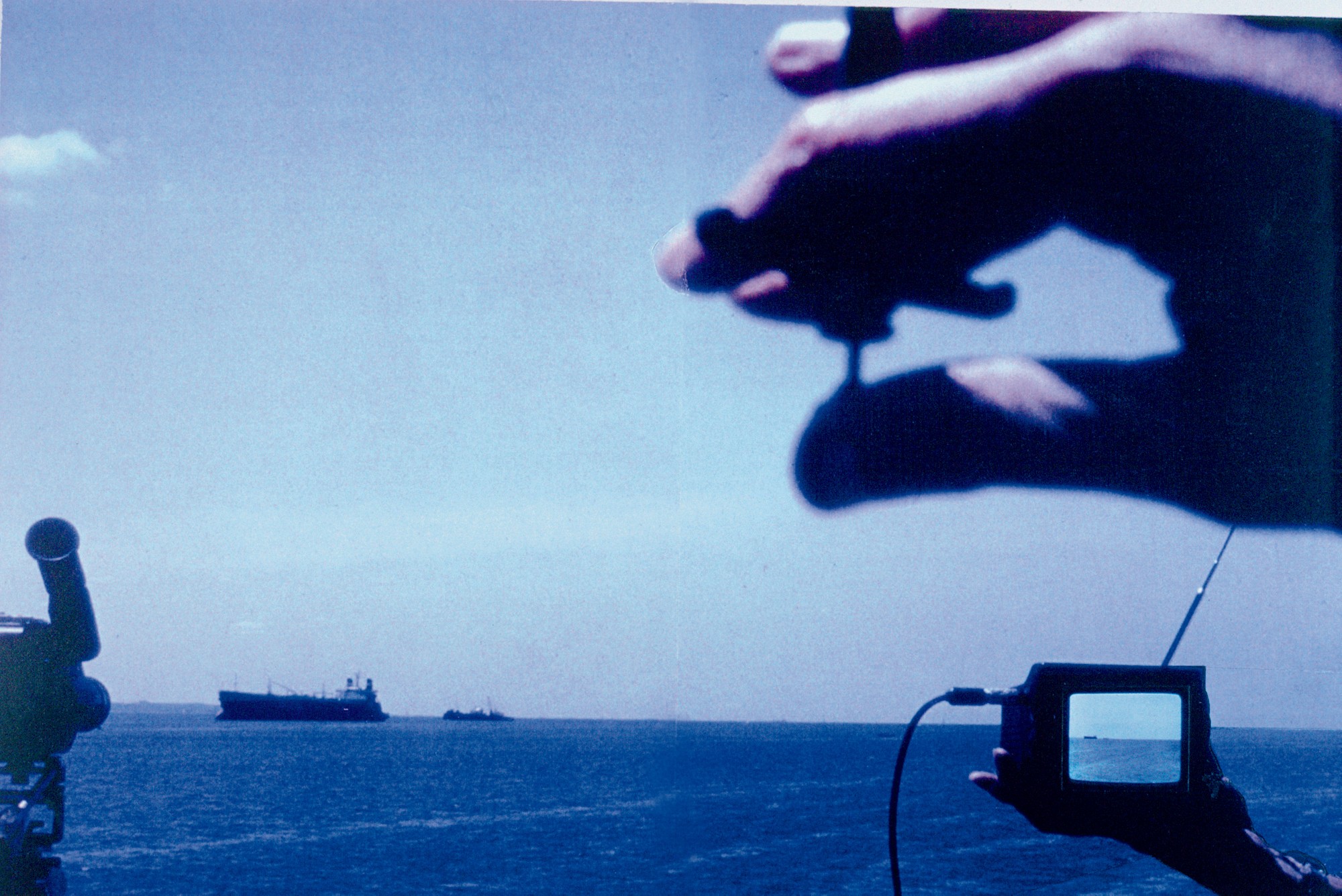 06 (1988-90) framed and recorded a particular view of Long Island, now a window in Nassau to frame a view of Copenhagen, Milan or Tokyo. The composite view formed by the screen collapses the opposition between the authentic and the mediated; screens can simulate the appearance of being anywhere, while still being in one’s own home.
06 (1988-90) framed and recorded a particular view of Long Island, now a window in Nassau to frame a view of Copenhagen, Milan or Tokyo. The composite view formed by the screen collapses the opposition between the authentic and the mediated; screens can simulate the appearance of being anywhere, while still being in one’s own home.Alternatively, we may still wish to force a particular, but not static, view onto the viewer. Rather than framing a view of the changing weather within a landscape, the lights and screens of Times Square force bystanders to watch the same advertisements, clips and news. The concept of media ornamenting a facade also allows images to speak to materiality. Paul Virilio comments on “buildings in some Asian cities with facades entirely made of screens,07 ultimately concluding that “in some way you can read the importance given today to glass and transparency as a metaphor of the disappearance of matter.”
A final difference is the window as a mode of communication. Previously, windows insulated sound between the interior and the exterior, between public and private realms. Although one could formerly open the window, lean out and speak to one’s neighbor, today one might use a screen to make a video call or record a message. Windows can be equated to screens, providing linkages and chaining spaces together across geographies. Rather than enforcing separations, windows act as gateways to the outside world. For Vitruvius the total view was constrained by how much of the visual field could be contained within an eye, whereas today the total view combines all the windowed fragments to reconstruct a new whole.
III. Spatial Manifestations of New Technologies
I now consider three situations in which the Synthetic View is already shaping contemporary architecture. The immense scope and rapid evolution of new technologies makes it difficult to draw overarching conclusions from select case-studies. Nevertheless, the Synthetic View’s relationship to the built environment can be summarized in terms of its impacts on (i) architectural organizations, and (ii) aesthetics.
Windowless Boxes
Since the Synthetic View is simultaneously both digital and human, there is an emphasis on the physical repositories that store the collective memories of digital cultures. These virtual spaces are housed in data centers of high cultural importance, camouflaged in secure but inconspicuous, banal sheds, often hidden in plain site. A relevant precedent here is Sir John Soane’s Bank of England (Fig. 6),
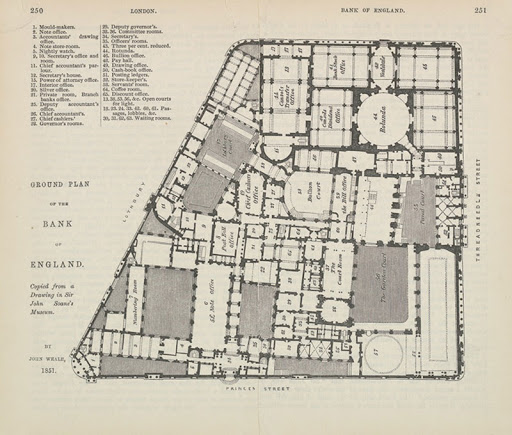 which stores a nation’s wealth in underground vaults beneath an urban center. Alternatively, data centers may be hidden in low density landscapes, where land and building are integrated to obscure the importance of these twenty-first relics. In either case, ornamentation is eliminated from the physical spaces that house the memories, secrets and raw data of contemporary society.
which stores a nation’s wealth in underground vaults beneath an urban center. Alternatively, data centers may be hidden in low density landscapes, where land and building are integrated to obscure the importance of these twenty-first relics. In either case, ornamentation is eliminated from the physical spaces that house the memories, secrets and raw data of contemporary society.A striking example of this style of power infrastructure is the AT&T Long Lines Building in Manhattan. (Fig. 6)
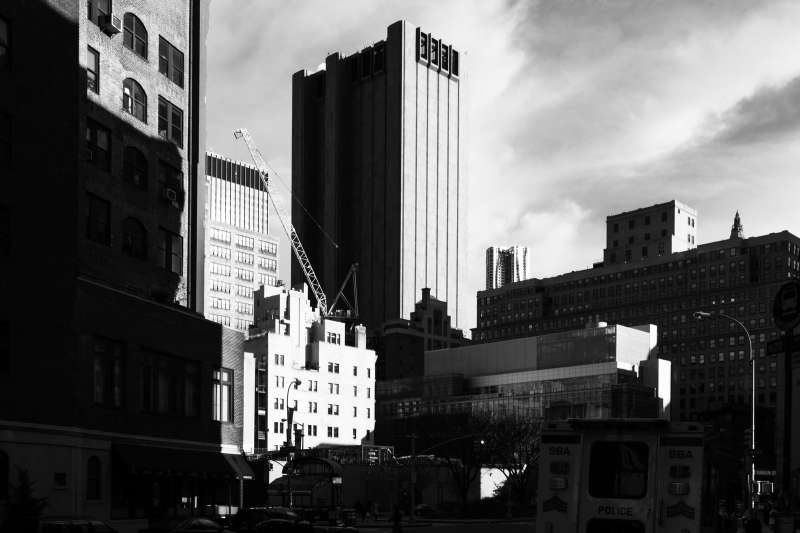 08 This windowless, 170m tall structure houses a telephone exchange, and was the likely site of the NSA mass surveillance hub codenamed TITANPOINTE. Here, the disappearance of the window is just as interesting as the conflation of windows for screens. A building without a window is one that is not open to the outside, that limits points of access; one cannot enter the building by crawling through a window. Thus, for security reasons, the resources needed to power our world of screen-windows are housed within monumental, but deeply banal structures, with no access to natural light and without the need to cater to human occupation.
08 This windowless, 170m tall structure houses a telephone exchange, and was the likely site of the NSA mass surveillance hub codenamed TITANPOINTE. Here, the disappearance of the window is just as interesting as the conflation of windows for screens. A building without a window is one that is not open to the outside, that limits points of access; one cannot enter the building by crawling through a window. Thus, for security reasons, the resources needed to power our world of screen-windows are housed within monumental, but deeply banal structures, with no access to natural light and without the need to cater to human occupation.The banality of data centers can be read as a contemporary example of camouflage. Camouflage not only addresses the thing in view; it must also consider the viewer. Prior to recent advances in data collection and vision technologies, camouflage has been a problem of legibility between two and three-dimensions. Now one might consider the climatic implications of space and materials read via infrared monitoring, how stealth geometries interfere with radar reflectivity, and what can be gleaned from Google Earth. Architectural form can push against identifiable signs, limiting the ability to identify composition, through the figuration of an object. The banality of data centers appears as the deepest form of camouflage: a black box that minimizes what can be deciphered from outside.
Architecture of Virtual Networks
The Foucaultian vision-and-power relationship has been shifted onto non-human agents, where visual scanning apperati, projection mapping, and algorithms all collect and store spatial information. The organization of these protocols and logics manifests in new architectures of power, as represented by the Apple Park campus in Cupertino, California (Fig. 7),
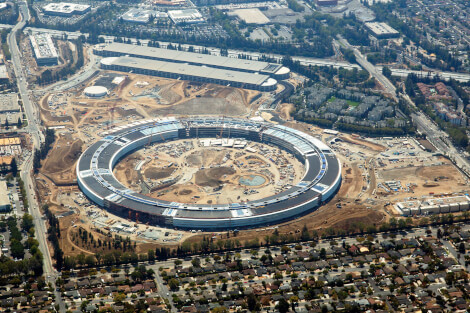 09 and by Google’s terraformed Charleston East Campus (currently undergoing construction). Apple Park is the physical representation of satellite vision. Having a clear footprint on Google Earth, the park’s ring structure is a decentralized diagram of top-down power—a figure that can only be read by the sky. Meanwhile, the curved campus windows promote an image of transparency, where glass shapes a public perception of friendliness and accessibility, and inhabitants can look across floor plates. But the ground in the center is bounded, secure and represents a clear territorialization of land.
09 and by Google’s terraformed Charleston East Campus (currently undergoing construction). Apple Park is the physical representation of satellite vision. Having a clear footprint on Google Earth, the park’s ring structure is a decentralized diagram of top-down power—a figure that can only be read by the sky. Meanwhile, the curved campus windows promote an image of transparency, where glass shapes a public perception of friendliness and accessibility, and inhabitants can look across floor plates. But the ground in the center is bounded, secure and represents a clear territorialization of land.Technological changes are visible not only in singular building forms, but also through various programmatic components as they are distributed across the city. Frank Duffy writes, “the revolution of New Technologies of Information and Communication requires rethinking the office building as an architectural style and urban component, to conceive of a profound design mutation similar to that which accompanied the industrial revolution.”10 With the rise of teleworking, flexible work hours and cloud servers that facilitate online collaboration, working spaces and office buildings are becoming more compact, adaptable, and untethered from the formalities of the Taylorist office structure that characterized work in the twentieth century. This brings into question how humans come to interface with the outside world and what models of ownership will be considered in the future.
Paradoxically, the evolution towards more flexible, mobile working environments suggests that corporate headquarters—one of the archetypal symbols of pastoral capitalism11—may evolve towards a more communal, decentralized model. Rather than being identified based on their employer, city inhabitants will be brought together through their technologies and shared urban infrastructures towards optimization. Thus, while Silicon Valley giants may produce the most monumental architecture of our time, their true scale may be better understood by considering the virtual networks of employees, dispersed throughout the world, who log in from home offices, co-working spaces and informal coffee shops.
Data as Vision
As a final case study, I define data as vision. Through the collection of (non-visual) data, it is now possible to recreate, in granular detail, the geometries and spatial qualities of a plan. In one example, information about the locations, plans and staffing of active US military sites was made publicly available when the fitness app “Strava” (Fig. 8)
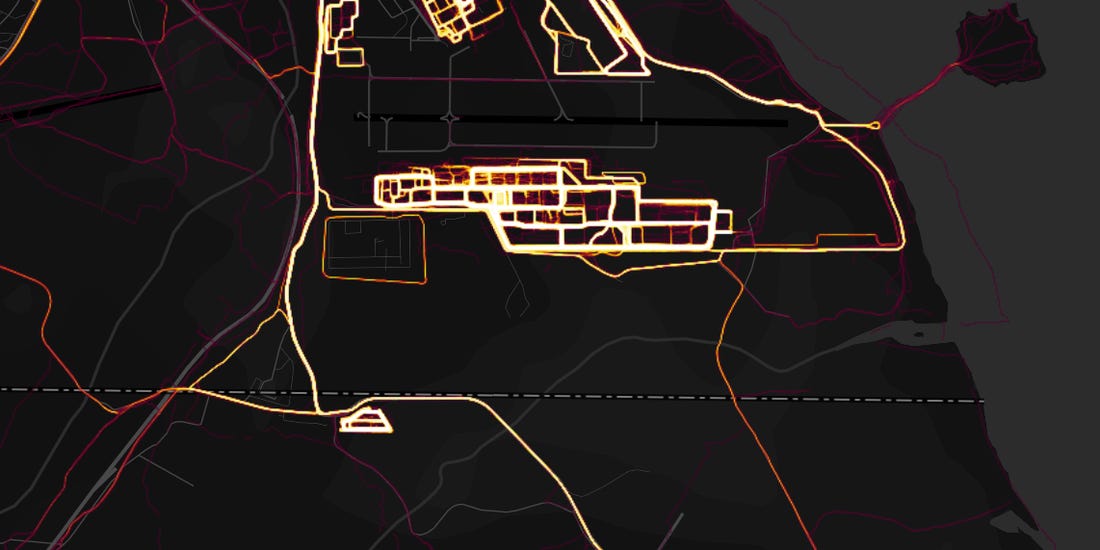 released a data visualisation map showing activities tracked by the app’s users. Other apps make it possible to visualize how materials move across dynamic systems, while satellite images allow highly sensitive, even lucrative information to be extrapolated: the fluctuations of stock prices can be predicted by tracking the duration and number of cars parked outside office parks.
released a data visualisation map showing activities tracked by the app’s users. Other apps make it possible to visualize how materials move across dynamic systems, while satellite images allow highly sensitive, even lucrative information to be extrapolated: the fluctuations of stock prices can be predicted by tracking the duration and number of cars parked outside office parks.Previously, buildings were conceptualized in singular, site-specific locations. Data as vision most radically transforms the process of architectural assembly, bringing together a loose association of disjunct material through the complexity of construction sequences, while also dislocating the viewer from the source of those materials. Vision-as-data reconstitutes materiality, constructing buildings as globally-produced artifacts, their parts trackable by barcode across a production sequence. It sees buildings as the combined representation of Roomba data, waste output, biometric tracking and utilities.
IV. Conclusion
There are two possible ways of defining the Synthetic View (House for an Ambassador, 2017-18). (Fig. 9)
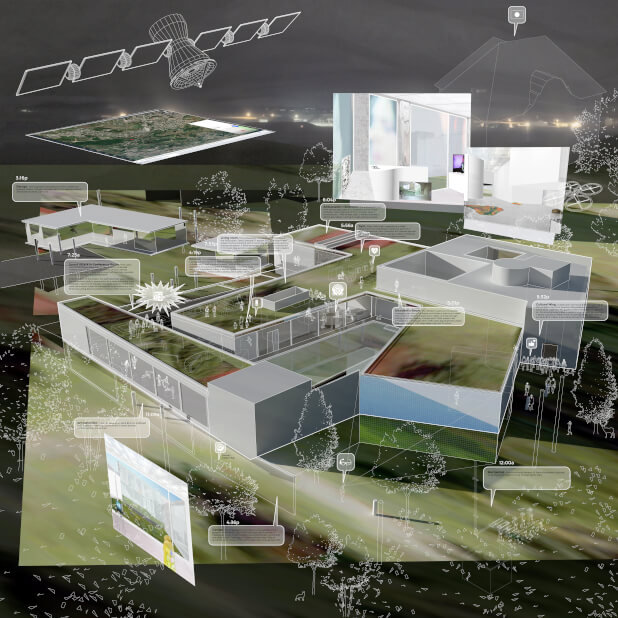 One definition fuses the real and digital into a total synthesis of artificial and human vision, blending the real and the digital into a third space. In this definition, one might imagine a Google “tourist” who views the world as a series of simulations across various data-types. The extensive range of post-digital representations alters what the tourist sees in each view, potentially giving them a fuller, more complete knowledge of a landmark or environment over a physical experience. This definition begs questions of whether to build for or against these new tourists, and how either of these can be achieved.
One definition fuses the real and digital into a total synthesis of artificial and human vision, blending the real and the digital into a third space. In this definition, one might imagine a Google “tourist” who views the world as a series of simulations across various data-types. The extensive range of post-digital representations alters what the tourist sees in each view, potentially giving them a fuller, more complete knowledge of a landmark or environment over a physical experience. This definition begs questions of whether to build for or against these new tourists, and how either of these can be achieved.The second definition of the Synthetic View translates meaning from outside the human privileged perspective to machines. Synthetic forms of vision organize spaces, though a protocol of digital logics, into structures that are not accessible to those who inhabit them. The intrigue of this vision is that it produces new modalities of representation and relationships to be read in the field, placing a great importance on data errors, or simply falsitudes. If an aberration in Google Earth creates a virtual island, is this in some sense real? Does the temporary malfunctioning of a scanning device put a hole in history? New technologies mean that false images, false narratives, false perspectives are easily created and disseminated—deliberately or unintentionally. Whereas the architecture of Vitruvius was aimed at absolute a priori Truth, today the datasets and simulations of the Synthetic View have come to define an ever-fluctuating post-Truth world.
Fig. 1 Malton, James. The Young Painter’s Maulstick: Being a Practical Treatise on Perspective, Containing Rules and Principles for Delineation on Planes... : Founded on the Clear Mechanical Process of Vignola and Sirigatti, united with the Theoretical Principles of the Celebrated Brook Taylor. RIBA London: Printed by V. Griffiths, 1800.
Fig. 2 Diller and Scofidio, Slow House, 1989-91. Image published as “Broken Horizon, rendering, 1989” in Scanning: The Aberrant Architectures of Diller + Scofidio (New York: Whitney Museum of American Art, 2003) 103.
Fig. 3 Warnecke, John Carl. AT&T Long Lines Building. Manhattan, New York, 1969. Building Photograph by Addison Godel (2013), “When Windows Were Wires: The Projection of Network Invulnerability and the Architecture of AT&T Long Lines,” Grey Room 61 (Fall 2015): 34–65.
Fig. 4 Apple Campus in Construction. Foster and Partners, Norman. Apple Campus Building. Cupertino, California, 2009-18.
Fig. 5 Shaffer, Gillian. House for an Ambassador. Princeton University, 2017-18.
Fig. 6 Graham, Dan. 2 Viewing Rooms. Museum of Modern Art, 1980.
Fig. 7 Le Roy, Julien David. Vue du temple d´Erecthée a Athenes. Engraved Plate, Paris delatour et Musier, 1770.
Fig. 8 Paglen, Trevor. They Watch the Moon. Print. 2010.
Fig. 9 Fitness app Strava lights up staff at military bases. 29 January 2018.
Fig. 10 Soane, Sir John. London, England. Drawing by John Weale, 1851.
01 Pollio, Vitruvius, Ingrid D. Rowland, Thomas Noble Howe, and Michael Dewar. Vitruvius: Ten Books on Architecture. New York: Cambridge University Press, 1999.
02 Foucault, Michel. The History of Sexuality. Vol. 1. Harmondsworth: Penguin/Pelican, 1981. Print. pp. 94.
03 Le Roy, Julien David. Les Ruines des plus beaux monuments de la Grèce. N.p.: n.p., 1758. Princeton University Plates.
04 Friedberg, Anne. The Virtual Window: from Alberti to Microsoft. Cambridge, Mass: MIT Press, 2009. pp.243.
05 Deleuze, Gilles. Cinema. Cinema 1: The Movement-Image, 1996.
06 Diller, Liz, Ricardo Scofidio. Slow House. North Haven, Long Island, 1988-90.
07 Virilio, Paul (1993) ‘Architecture in the Age of Its Virtual Disappearance: An Interview with Paul Virilio.’
08 Warnecke, John Carl. AT&T Long Lines Building. Manhattan, New York, 1969.
09 Foster and Partners, Norman. Apple Campus Building. Cupertino, California, 2009-18.
10 Duffy, Frank. The Office and The City: Twelve Propositions. Articles “STREAM”: https://www.pca-stream.com/en/articles/the-office-and-the-city-twelve-propositions-39.
11 Mozingo, Louise A. Pastoral Capitalism: A History of Suburban Corporate Landscapes. The MIT Press, 2016.
Year: 2017
Location: Bolzano, Italy (unbuilt)
Project Team:Gillian Shaffer
Program: Archaeological Site Monument & Museum, 3035 sqm
The discovery of the mummy, Ötzi, and the following years of his excavation prompted an architectural brief for the design of two sites. The project was conceived around both the transference of artifacts from one site to another and the archeologist’s construction of knowledge from found artifacts, more generally. Together, these were used to draw concepts for the two sites – a monument to memorialize Ötzi’s finding and a museum in Bolzano to display his body and tools.
Ötzi presents a constellation of himself through the assemblage of his tools. As the ground shifts under the melting of glaciers, erosion by the elements, and the continuous process of geologic transformation, his tools are scattered; today, the fluid borders of the surrounding territories leave his body contested. His fragmented tools are a series of parts that read together as a whole figure. Sited on the mountain, a wire mesh structure, sharing the formal language of the museum, is proposed. The wire mesh will continually freeze over. The harsh, ephemeral qualities of the weather and climate will, in one phase, cover the mesh with freezing ice and dripping water, and in the other, expose the lightness of the wireframe mesh.
The body of Ötzi is transported to the city to be viewed, with his tools reassembled into an architectural form to reconstruct his total figure. His fragmented artifacts – the rainproof coat, the sleeping mat, the container of his backpack, his multi-function tool, and others – have us speculating as to their original uses, where speculation and the actual situation of Ötzi creates an ontological gap. The permanent exhibition rooms are walled in glass brick and share a spatial transparency, allowing visitors to see across levels and glass courtyards, while sensing movement upward during the promenade sequence inside. The plan produces incongruity of building fragments that don’t quite fit together. These stranded spaces lift off of the existing building platform in the direction of the mountain site, with occasional punctures for windows to frame the view. Taken as a whole, architecture produces a new figure in which Ötzi is one of his body and of his tools.